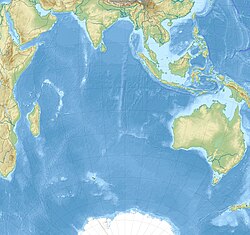| Massif Gallieni | |
|---|---|
| Gallieni Massif | |
 View of the Gallieni Massif across the Morbihan Gulf | |
| Highest point | |
| Peak | Mont Ross |
| Elevation | 1,850 m (6,070 ft) |
| Coordinates | 49°35′32″S69°29′45″E / 49.59222°S 69.49583°E [1] |
| Dimensions | |
| Length | 18 km (11 mi)NW/SE |
| Width | 10 km (6.2 mi)NE/SW |
| Geography | |
| Geology | |
| Rock type | Stratovolcano |
The Gallieni Massif (French : Massif Gallieni) is a mountain range in Grande Terre, the main island of Kerguelen in the French Southern Territories zone of the Southern Indian Ocean. [2]



